The Interplay between Canopy Structure and Topography and Its Impacts on Seasonal Variations in Surface Reflectance Patterns in the Boreal Region of Alaska—Implications for Surface Radiation Budget
Abstract
:1. Introduction
2. Materials and Methods
2.1. Study Area
2.2. Data
2.3. Methodology
3. Results
3.1. Relationship between Canopy Structure, Topography, and Land Cover Types
3.2. Land Cover Types, Canopy Structures, and Surface Reflectance Pattern
3.3. Surface Reflectance as a Function of Topography
3.4. Contribution of Topography and Canopy Structure on Surface Reflectance Pattern
4. Discussion
5. Conclusions
Author Contributions
Funding
Institutional Review Board Statement
Informed Consent Statement
Data Availability Statement
Acknowledgments
Conflicts of Interest
References
- Alibakhshi, S.; Naimi, B.; Hovi, A.; Crowther, T.W.; Rautiainen, M. Quantitative analysis of the links between forest structure and land surface albedo on a global scale. Remote Sens. Environ. 2020, 246, 111854. [Google Scholar] [CrossRef]
- Hardiman, B.S.; Bohrer, G.; Gough, C.M.; Vogel, C.S.; Curtis, P.S. The role of canopy structural complexity in wood net primary production of a maturing northern deciduous forest. Ecology 2011, 92, 1818–1827. [Google Scholar] [CrossRef] [PubMed] [Green Version]
- Kötz, B.; Schaepman, M.; Morsdorf, F.; Bowyer, P.; Itten, K.; Allgöwer, B. Radiative transfer modelling within a heterogeneous canopy for estimation of forest fire fuel properties. Remote Sens. Environ. 2004, 92, 332–344. [Google Scholar] [CrossRef]
- Myneni, R.B.; Ramakrishna, R.; Nemani, R.; Running, S.W. Estimation of global leaf area index and absorbed par using radiative transfer models. IEEE Trans. Geosci. Remote Sens. 1997, 35, 1380–1393. [Google Scholar] [CrossRef] [Green Version]
- Ogunjemiyo, S.; Parker, G.; Roberts, D. Reflections in bumpy terrain: Implications of canopy surface variations for the radiation balance of vegetation. IEEE Geosci. Remote Sens. Lett. 2005, 2, 90–93. [Google Scholar] [CrossRef]
- Goel, N.S. Models of vegetation canopy reflectance and their use in estimation of biophysical parameters from reflectance data. Remote Sens. Rev. 1988, 4, 1–212. [Google Scholar] [CrossRef]
- Williams, D.L. A comparison of spectral reflectance properties at the needle, branch, and canopy level for selected conifer species. Remote Sens. Environ. 1991, 35, 79–93. [Google Scholar] [CrossRef]
- Ni, W.; Li, X.; Woodcock, C.E.; Caetano, M.; Strahler, A.H. An analytical model of bidirectional reflectance over discontinuous plant canopies. IEEE Trans. Geosci. Remote Sens. 1999, 37, 987–999. [Google Scholar]
- Chen, J.M.; Li, X.; Nilson, T.; Strahler, A. Recent advances in geometrical optical modelling and its applications. Remote Sens. Rev. 2000, 18, 227–2262. [Google Scholar] [CrossRef]
- Grabska, E.; Socha, J. Evaluating the effect of stand properties and site conditions on the forest reflectance from Sentinel-2 time series. PLoS ONE 2021, 16, e0248459. [Google Scholar] [CrossRef]
- Ni, W.; Woodcock, C.E. Effect of canopy structure and the presence of snow on the albedo of boreal conifer forest. J. Geophys. Res. 2000, 105, 11879–11888. [Google Scholar] [CrossRef]
- Heinilä, K.; Salminen, M.; Metsämäki, S.; Pellikka, P.; Koponen, S.; Pulliainenm, J. Reflectance variation in boreal landscape during the snow melting period using airborned imaging spectroscopy. Int. J. Appl. Earth Obs. Geoinf. 2019, 76, 66–76. [Google Scholar] [CrossRef]
- Schneider, E.E.; Affleck, D.L.R.; Larson, A.J. Tree spatial patterns modulate peak snow accumulation and snow disappearance. For. Ecol. Manag. 2019, 441, 9–19. [Google Scholar] [CrossRef]
- Jost, G.; Weiler, M.; Gluns, D.R.; Alila, Y. The influence of forest and topography on snow accumulation and melt at the watershed-scale. J. Hydrol. 2007, 347, 101–115. [Google Scholar] [CrossRef]
- Varhola, A.; Coops, N.C.; Weiler, M.; Moore, R.D. Forest canopy effects on snow accumulation and ablation: An integrative review of empirical results. J. Hydrol. 2010, 392, 219–233. [Google Scholar] [CrossRef]
- Webster, C.; Jonas, T. Influence of canopy shading and snow coverage on effective albedo in a snow-dominated evergreen needleleaf forest. Remote Sens. Environ. 2018, 214, 48–58. [Google Scholar] [CrossRef]
- Cherubini, F.; Hu, X.; Vezhapparambu, S.; Stømman, A.H. High-resolution mapping and modelling of surface albedo in Norwegian boreal forests: From remotely sensed data to predictions. Geophys. Res. Abstr. 2017, 19, 8051. [Google Scholar]
- Hao, D.; Wen, J.; Xiao, Q.; Wu, S.; Lin, X.; Dou, B.; You, D.; Tang, Y. Simulation and analysis of the topographic effects on snow-free albedo over rugged terrain. Remote Sens. 2019, 10, 278. [Google Scholar] [CrossRef] [Green Version]
- Wang, Q.; Ni-meister, W. Forest canopy height and gaps using BRDF index assessed with airborne lidar data. Remote Sens. 2019, 11, 2566. [Google Scholar] [CrossRef] [Green Version]
- Li, X.; Strahler, A.; Woodcock, C. A hybrid geometric optical-radiative transfer approach for modeling albedo and directional reflectance of discontinuous canopies. IEEE Trans. Geosci. Remote Sens. 1995, 33, 466–480. [Google Scholar] [CrossRef]
- Ni-Meister, W.; Yang, W.; Kiang, N. A clumped-foliage canopy radiative transfer model for a global dynamic terrestrial ecosystem model I: Theory. Agric. For. Meteorol. 2010, 150, 881–894. [Google Scholar] [CrossRef]
- Ni, W.; Li, X.; Woodcock, C.; Roujean, J.-L.; Davis, R.E. Transmission of solar radiation in boreal conifer forests: Measurements and models. J. Geophys. Res. 1997, 102, 29555–29566. [Google Scholar] [CrossRef]
- Ni-Meister, W.; Gao, H. Assessing the impacts of vegetation heterogeneity on energy fluxes and snowmelt in boreal forests. J. Plant Ecol. 2011, 4, 37–47. [Google Scholar] [CrossRef]
- Markiet, V.; Mõttus, M. Estimation of boreal forest floor reflectance from airborned hyperspectral data of coniferous forests. Remote Sens. Environ. 2020, 249, 112018. [Google Scholar] [CrossRef]
- Gallant, A.L.; Binnian, E.F.; Omernik, J.M.; Shasby, M.B. Ecoregions of Alaska. In U.S. Geological Survey Professional Paper 1567; U.S. Gov. Printing Office: Washington, DC, USA, 1995; 78p. [Google Scholar]
- U.S. Geological Survey. Landsat Surface Reflectance. Available online: https://www.usgs.gov/core-science-systems/nli/landsat/landsat-collection-2-surface-reflectance (accessed on 1 December 2020).
- Cook, B.D.; Corp, L.A.; Nelson, R.F.; Middleton, E.M.; Morton, D.C.; McCorkel, J.T.; Masek, J.G.; Ranson, K.J.; Ly, V.; Montesano, P.M. NASA Goddard’s Lidar, Hyperspectral and Thermal (G-LiHT) airborne imager. Remote Sens. 2013, 5, 4045–4066. [Google Scholar] [CrossRef] [Green Version]
- Wickham, J.; Homer, C.; Vogelmann, J.; McKerrow, A.; Mueller, R.; Herold, N.; Coulston, J. The multi-resolution land characteristics (MRLC) consortium–20 years of development and integration of USA land cover data. Remote Sens. 2014, 6, 7424–7441. [Google Scholar] [CrossRef] [Green Version]
- Freese, F. Linear Regression Methods for Forest Research; US Department of Agriculture, Forest Service, Forest Products Laboratory: Washington, DC, USA, 1964; Volume 17, 148p.
- Hebbali, A. Tools for Building OLS Regression Models. Package Olsrr. 2018. Available online: https://cran.r-project.org/web/packages/olsrr/index.html (accessed on 27 May 2021).
- Akaike, H. A new look at the statistical model identification. IEEE Trans. Autom. Control 1974, 19, 716–723. [Google Scholar] [CrossRef]
- Maack, J.; Lingenfelder, M.; Weinacker, H.; Koch, B. Modelling the standing timber volume of Baden_Wurttemberg–a large-scale approach using a fusion of Landsat, airborne LiDAR and national forest inventory data. Int. J. Appl. Earth Obs. Geoinf. 2016, 49, 107–116. [Google Scholar] [CrossRef]
- Ravindra, K.; Rattan, P.; Mor, S.; Aggarwal, A.N. Generalized additive models: Building evidence of air pollution, climate change and human health. Environ. Int. 2019, 132, 104987. [Google Scholar] [CrossRef]
- Wood, S. Generalized Additive Models: An Introduction with R, 2nd ed.; CRC Press: London, UK, 2017; 496p. [Google Scholar]
- Gough, C.M.; Atkins, J.W.; Fahey, R.T.; Hardiman, B.S.; LaRue, E.A. Community and structural constraints on the complexity of eastern North American forests. Glob. Ecol. Biogeogr. 2020, 29, 2107–2118. [Google Scholar] [CrossRef]
- Sommer, C.G.; Lehning, M.; Mott, R. Snow in a very steep rock face: Accumulation and redistribution during and after a snowfall event. Front. Earth Sci. 2015, 3, 73. [Google Scholar] [CrossRef] [Green Version]
- Gough, C.M.; Atkins, J.W.; Fahey, R.T.; Hardiman, B.S. High rates of primary production in structurally complex forests. Ecology 2019, 100, 1–6. [Google Scholar] [CrossRef] [Green Version]
- Pan, P.; Chen, G.; Saruta, K.; Terata, Y. Snow cover detection based on visible red and blue channel from MODIS imagery data. Int. J. Geosci. 2015, 6, 51–66. [Google Scholar] [CrossRef] [Green Version]
- Atkins, J.W.; Fahey, R.T.; Hardiman, B.S.; Gough, C.M. Forest canopy structural complexity and light absorption relationships at the subcontinental scale. J. Geophys. Res. Biogeosci. 2018, 123, 1387–1405. [Google Scholar] [CrossRef]
- Lukeš, P.; Stenberg, P.; Rautiainen, M. Relationship between forest density and albedo in the boreal zone. Ecol. Model. 2013, 261–262, 74–79. [Google Scholar] [CrossRef]
- Dore, S.; Montes-Helu, M.; Hart, S.C.; Hungate, B.A.; Koch, G.W.; Moon, J.B.; Finkral, A.J.; Kolb, T.E. Recovery of ponderosa pine ecosystem carbon and water fluxes from thinning and stand-replacing fire. Glob. Chang. Biol. 2012, 18, 3171–3185. [Google Scholar] [CrossRef]
- Nevo, E. Evolution of genome-phenome diversity under environmental stress. Proc. Natl. Acad. Sci. USA 2001, 98, 6233–6240. [Google Scholar] [CrossRef] [PubMed] [Green Version]
- Wen, J.; Liu, Q.; Xiao, Q.; Liu, Q.; You, D.; Hao, D.; Wu, S.; Lin, X. Characterizing land surface anisotropic reflectance over rugged terrain: A review of concepts and recent developments. Remote Sens. 2018, 10, 370. [Google Scholar] [CrossRef] [Green Version]
- Kumar, L.; Skidmore, A.K.; Knowles, E. Modelling topographic variation in solar radiation in a GIS environment. Int. J. Geogr. Inf. Sci. 1997, 11, 475–497. [Google Scholar] [CrossRef]
- Chen, J.M.; Chen, X.; Ju, W. Effects of vegetation heterogeneity and surface topography on spatial scaling of net primary productivity. Biogeosciences 2013, 10, 4879–4896. [Google Scholar] [CrossRef] [Green Version]
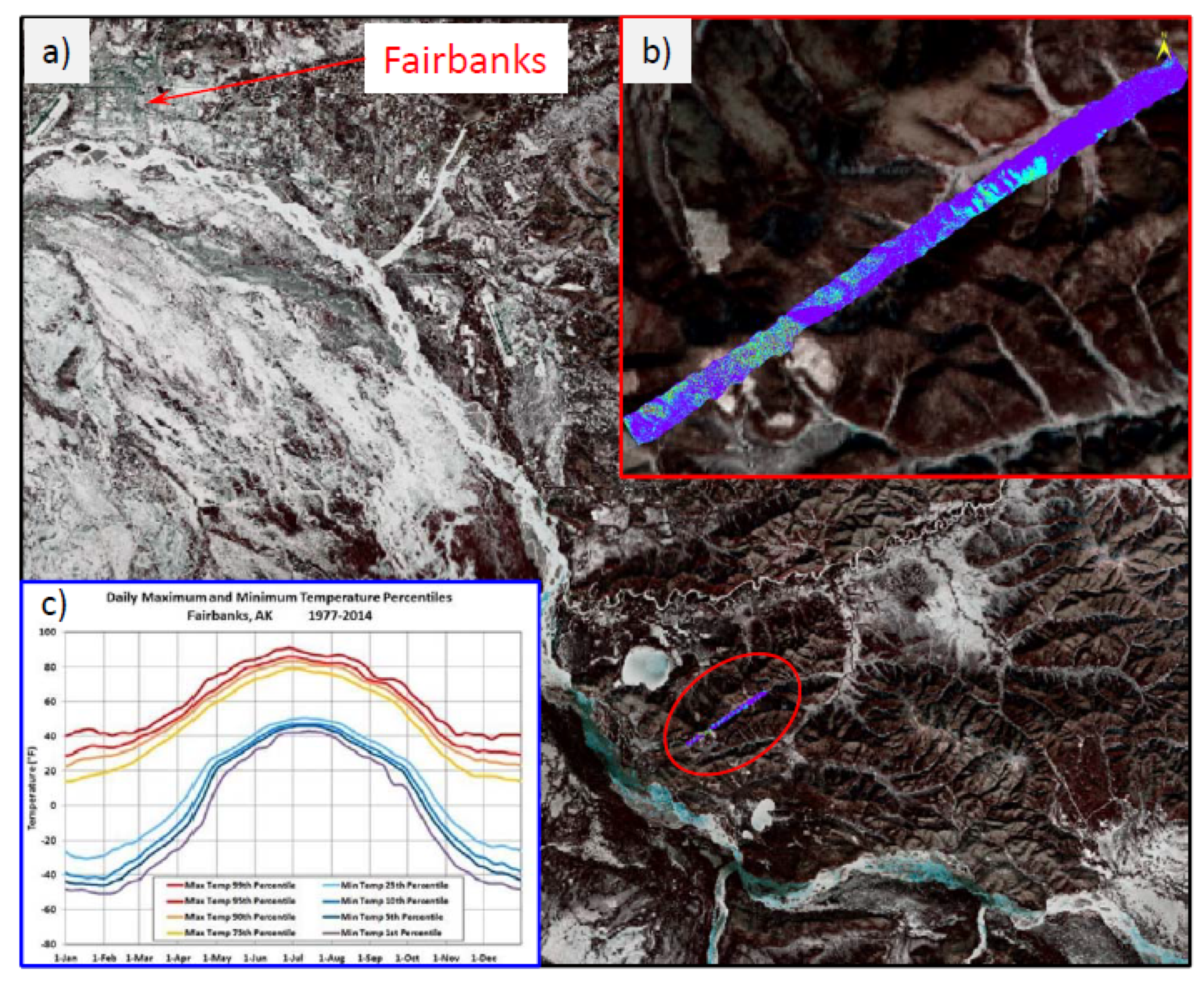
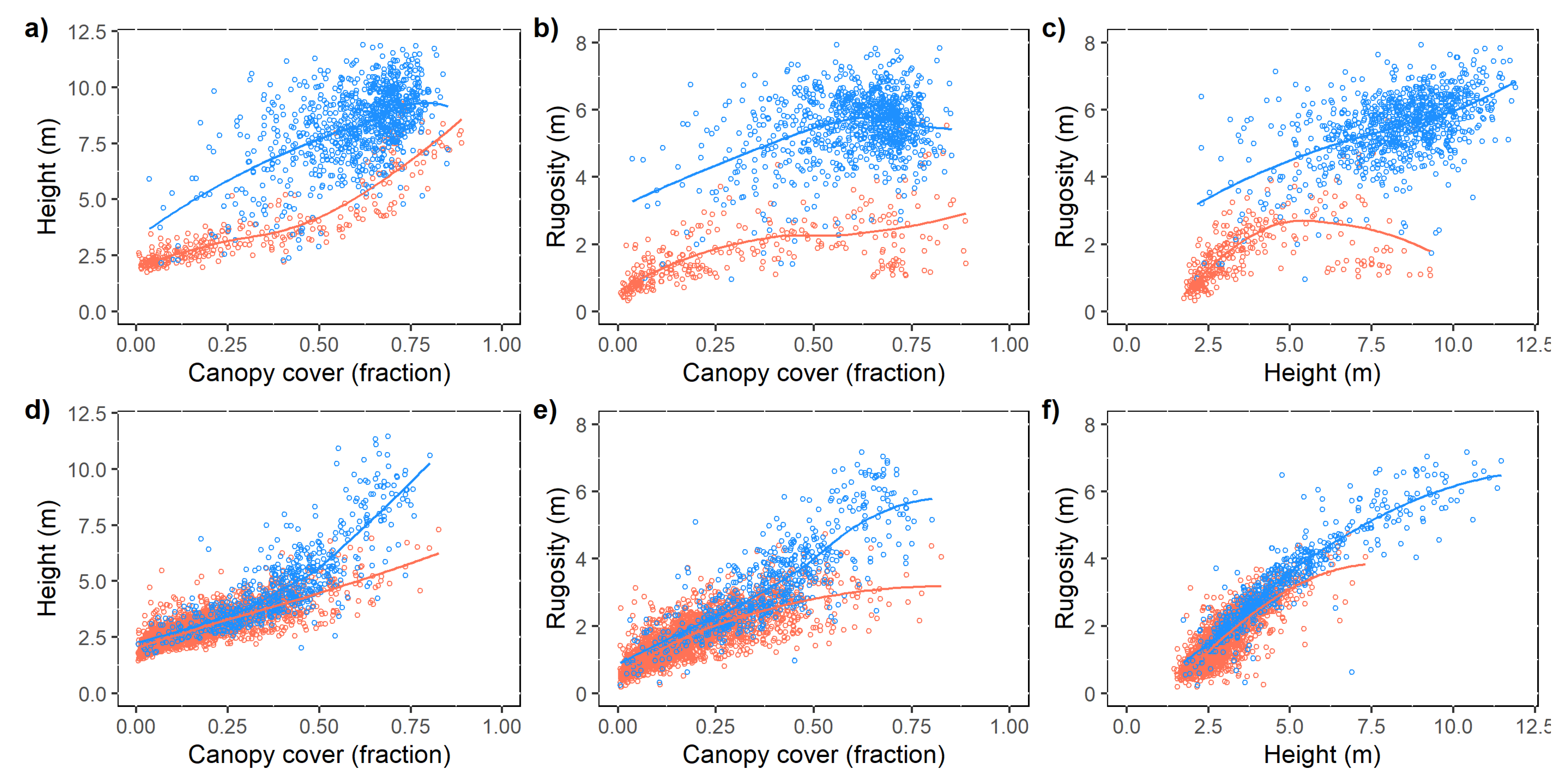
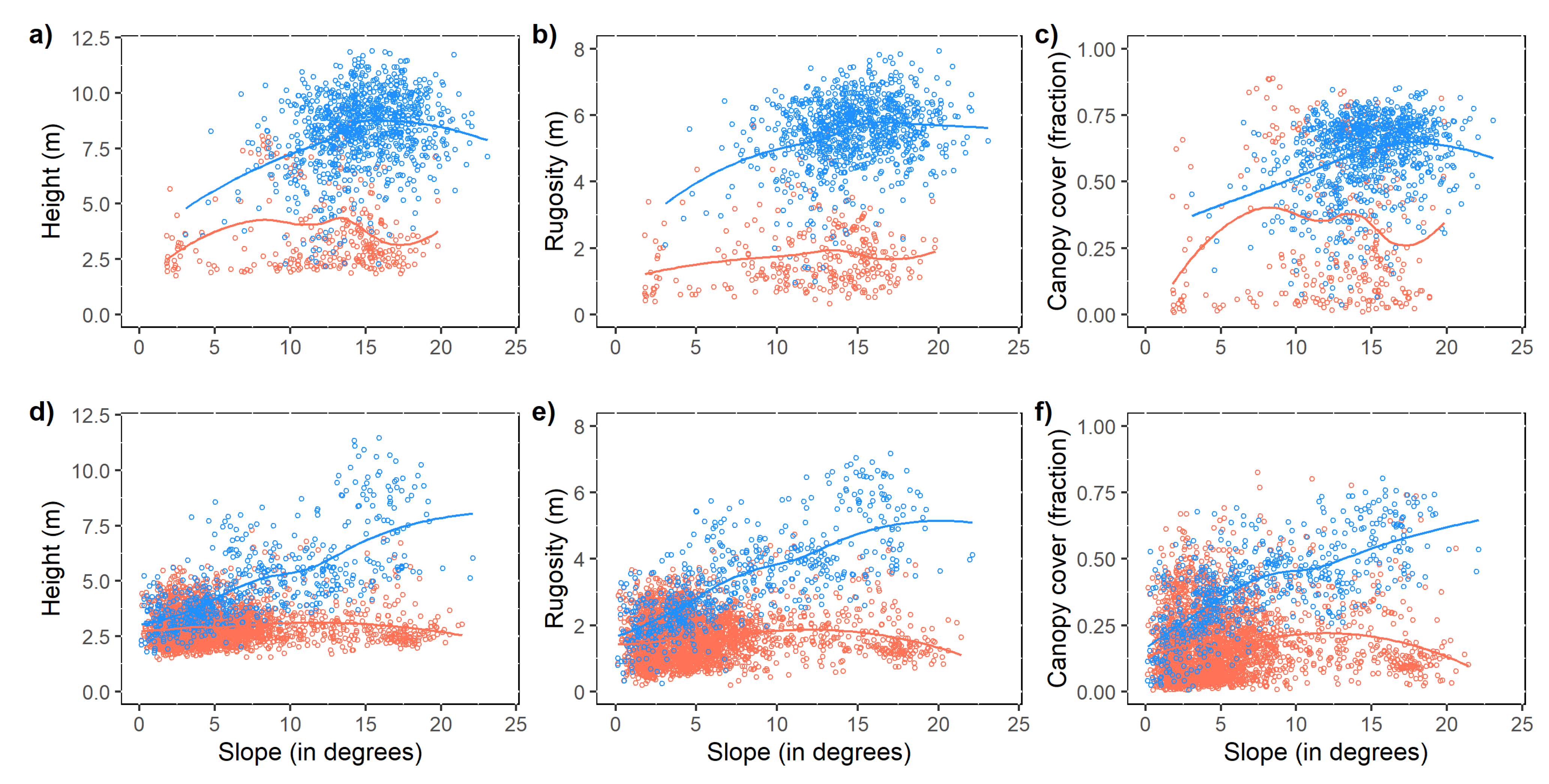

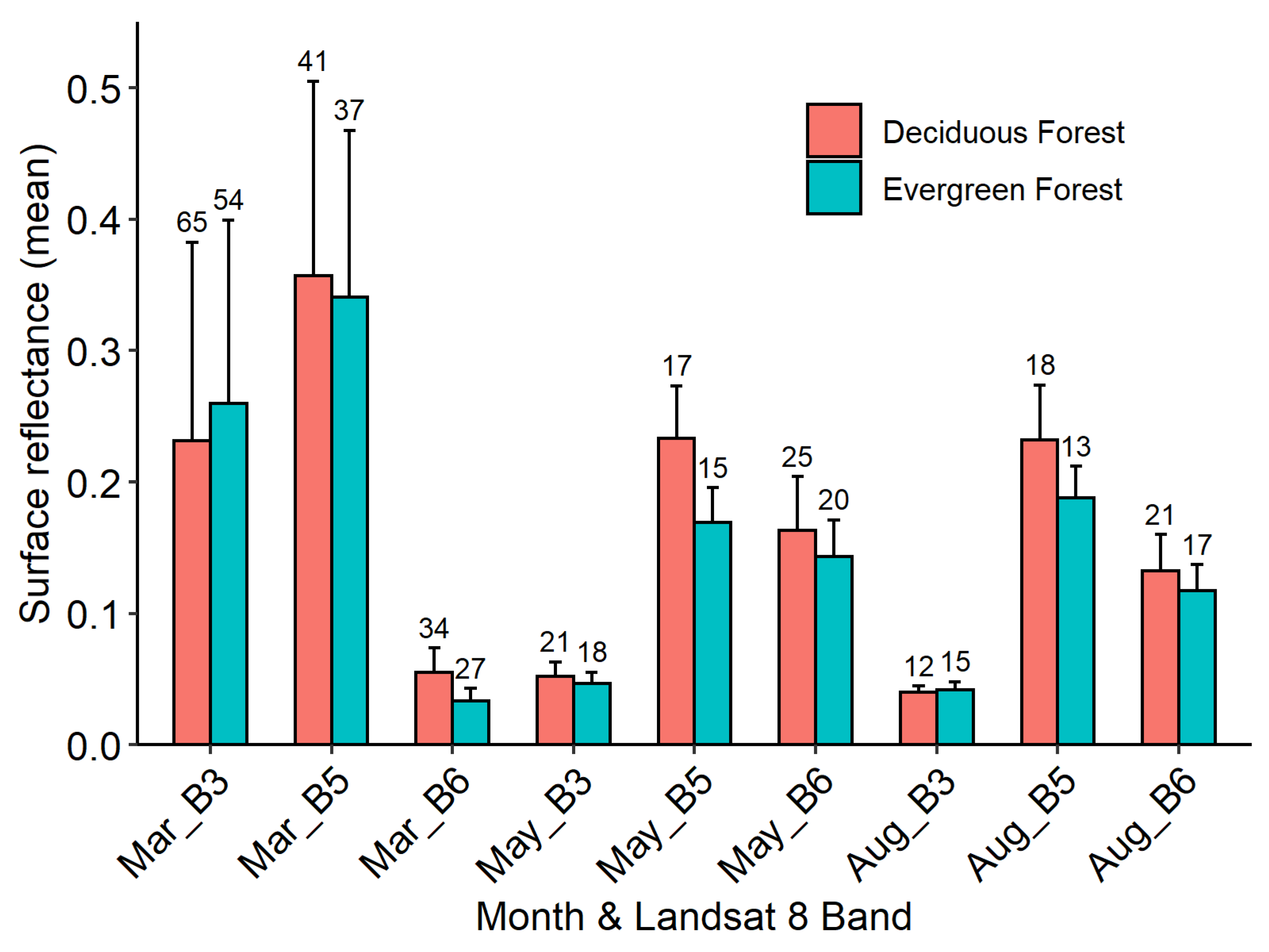
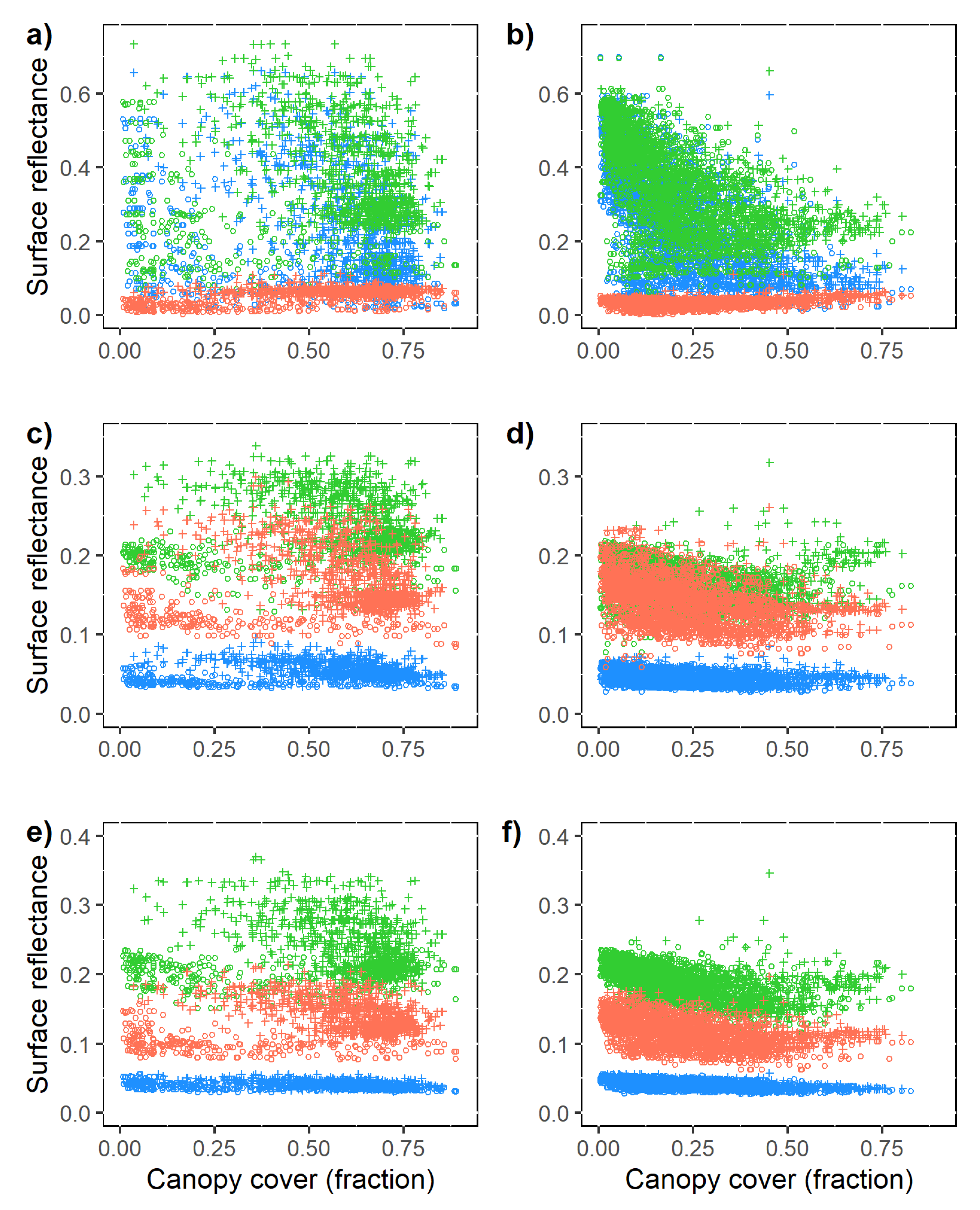

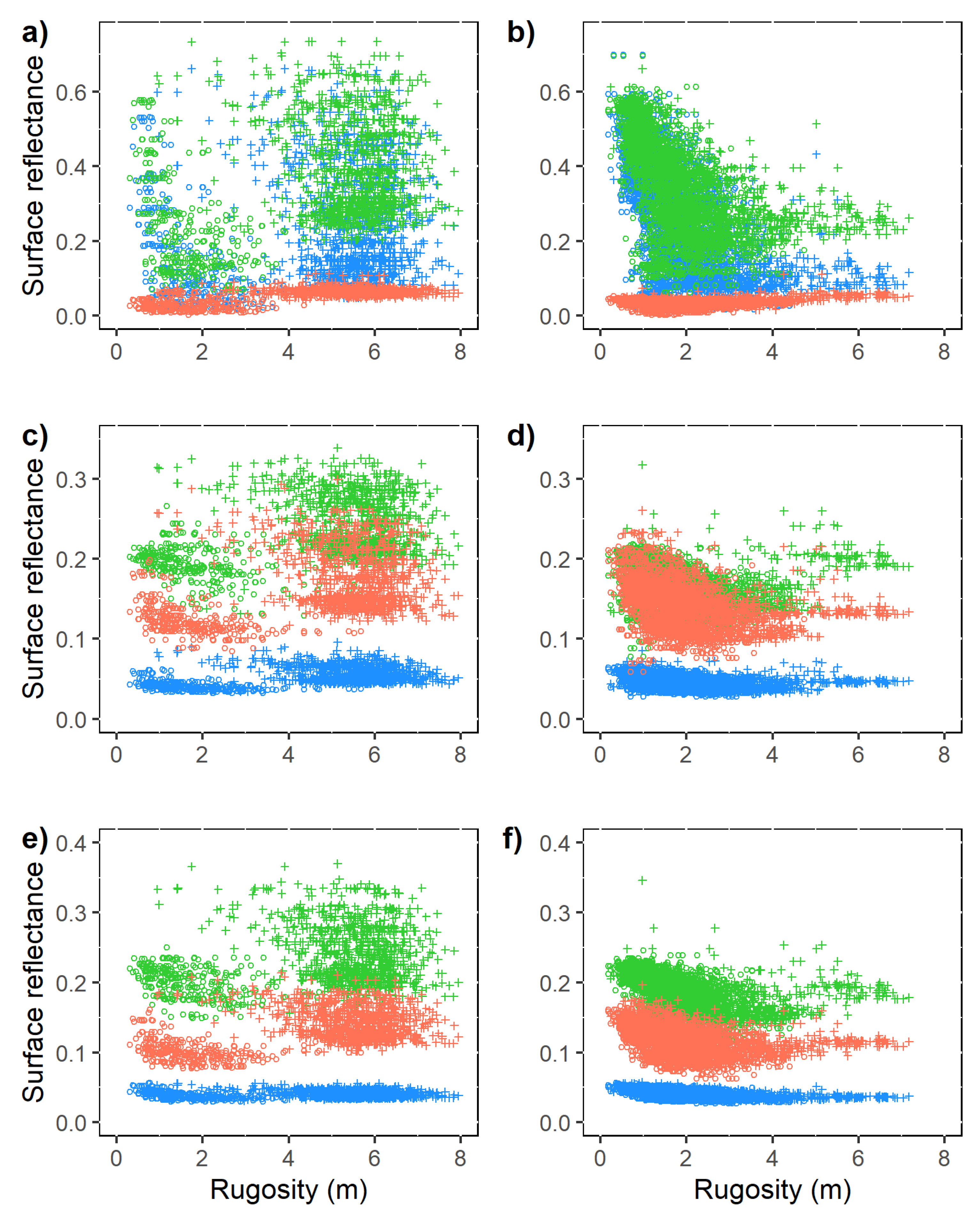
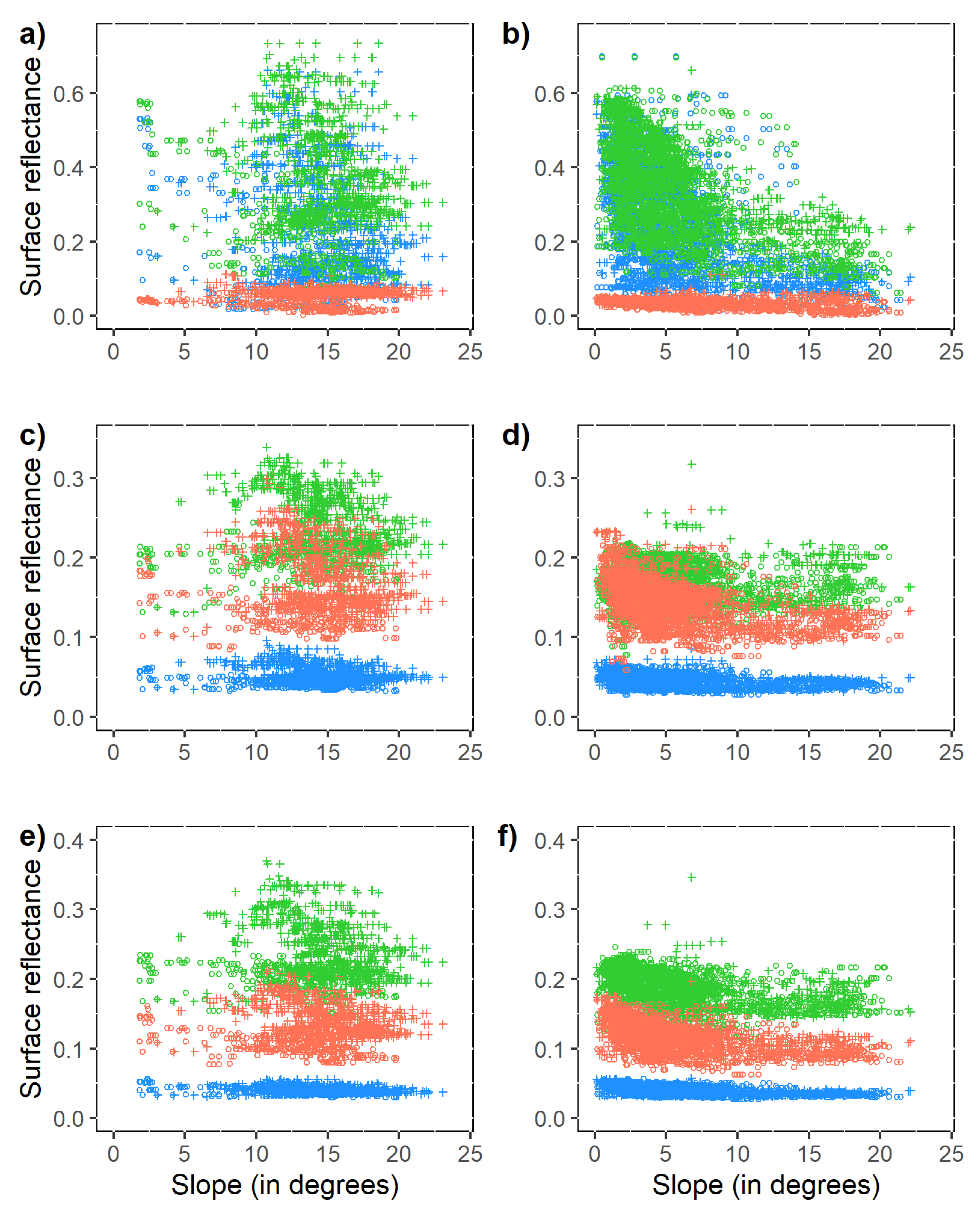

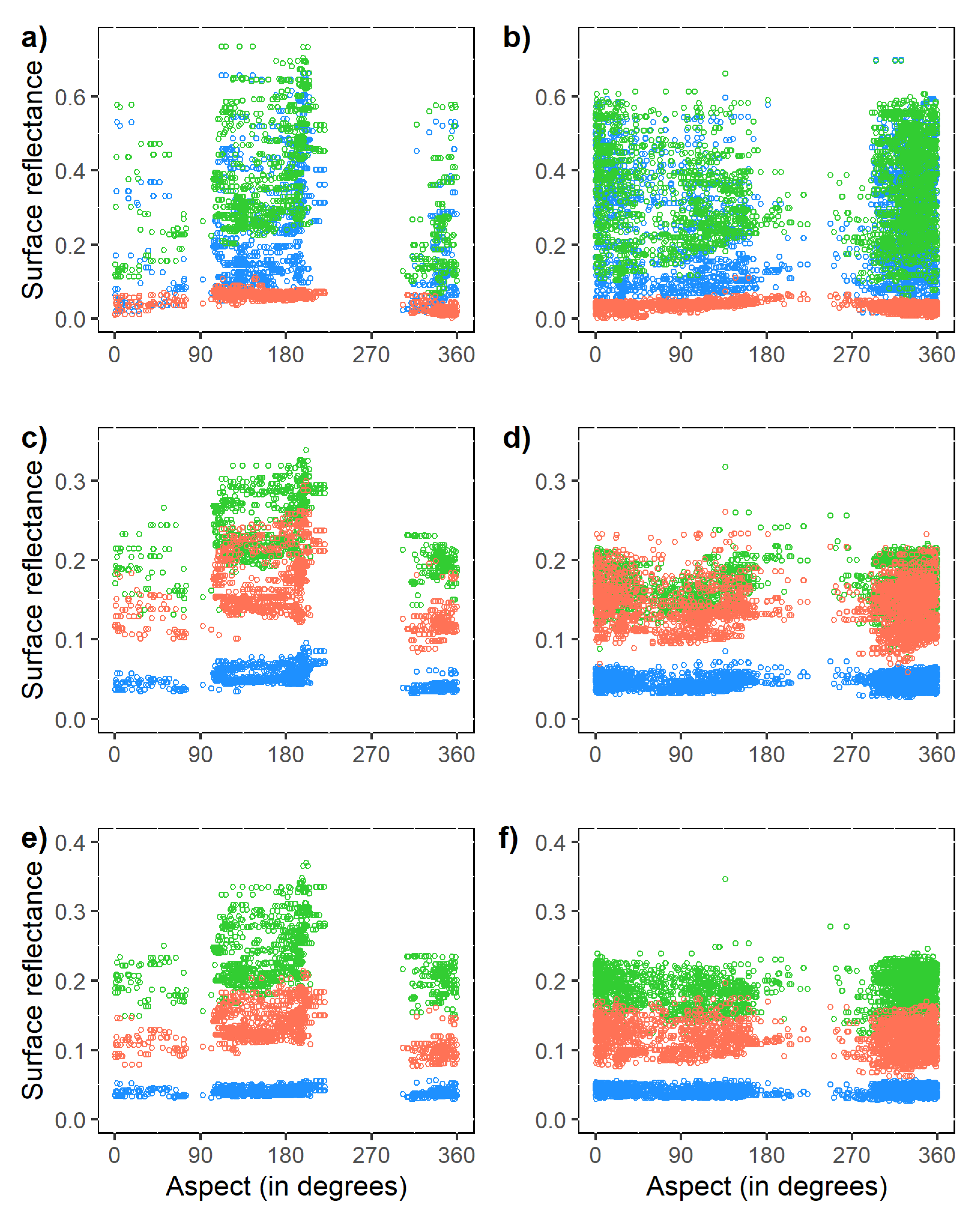
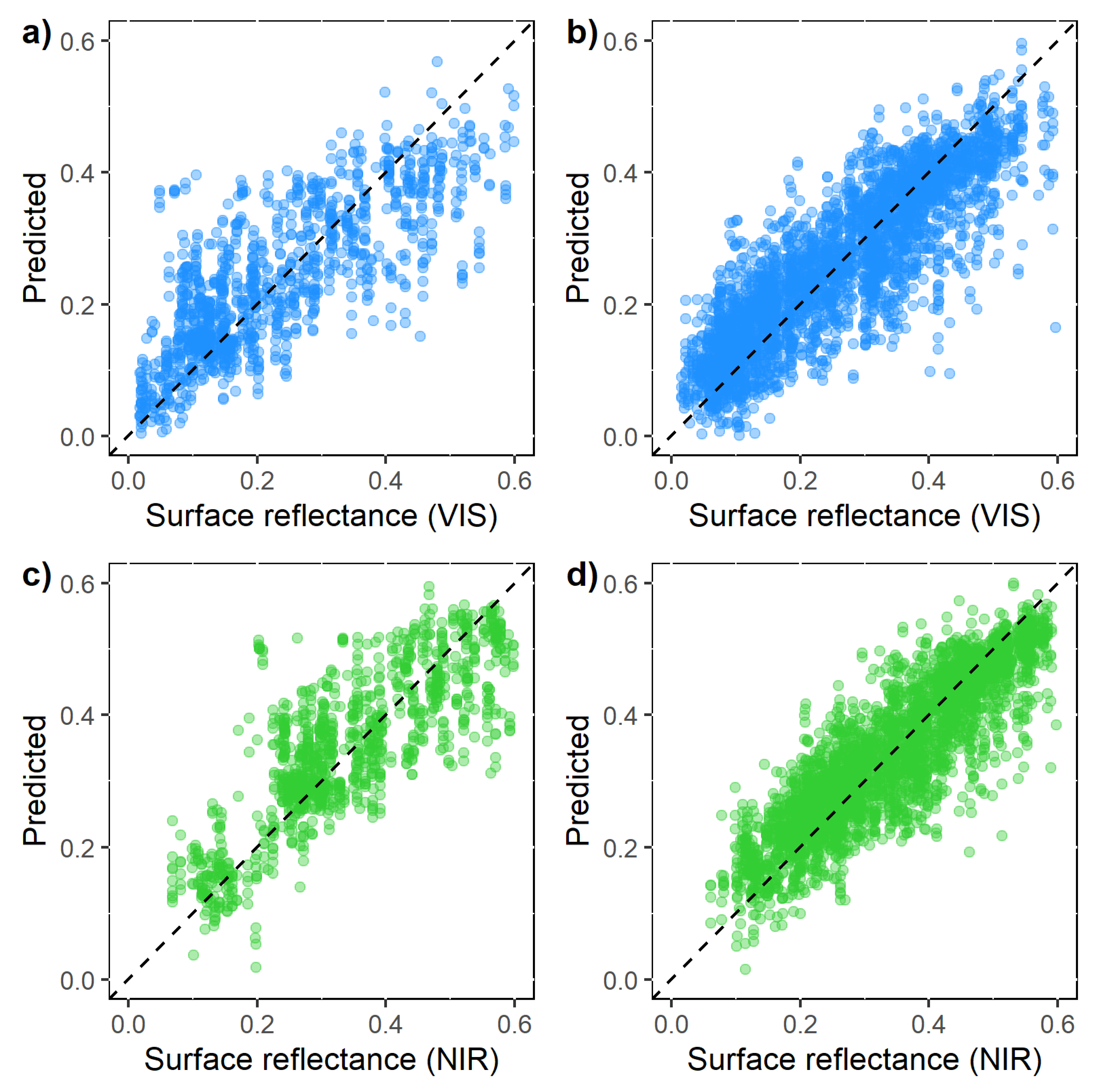
| Land Cover Type |
Band (Wavelength) | Winter Scene (March 2014) | Summer Scene (August 2014) | ||
|---|---|---|---|---|---|
| Variables | R-sq. (adj) | Variables | R-sq. (adj) | ||
| Evergreen forest | Visible (0.53–0.59 μm) | Canopy cover | 0.479 | nd | nd |
| Elevation | 0.422 | nd | nd | ||
| Canopy cover + Elevation | 0.619 | nd | nd | ||
| Canopy cover + Rugosity + Slope + Aspect + Elevation | 0.738 | nd | nd | ||
| Near-infrared (0.85–0.88 μm) | Rugosity | 0.442 | Rugosity | 0.43 | |
| Elevation | 0.426 | Elevation | 0.373 | ||
| Rugosity + Elevation | 0.608 | Rugosity + Elevation | 0.537 | ||
| Canopy cover + Rugosity + Slope + Aspect + Elevation | 0.758 | Canopy cover + Rugosity + Slope + Aspect + Elevation | 0.66 | ||
| Deciduous forest | Visible (0.53–0.59 μm) | Rugosity | 0.129 | nd | nd |
| Elevation | 0.481 | nd | nd | ||
| Elevation + Tree height | 0.505 | nd | nd | ||
| Elevation + Slope + Tree height | 0.602 | nd | nd | ||
| Near-infrared (0.85–0.88 μm) | Rugosity | 0.225 | Rugosity | 0.125 | |
| Elevation | 0.586 | Elevation | 0.469 | ||
| Elevation + Tree height | 0.598 | Elevation + Slope | 0.579 | ||
| Elevation + Slope + Tree height | 0.678 | Elevation + Slope + Tree height | 0.584 | ||
Publisher’s Note: MDPI stays neutral with regard to jurisdictional claims in published maps and institutional affiliations. |
© 2021 by the authors. Licensee MDPI, Basel, Switzerland. This article is an open access article distributed under the terms and conditions of the Creative Commons Attribution (CC BY) license (https://creativecommons.org/licenses/by/4.0/).
Share and Cite
Nath, B.; Ni-Meister, W. The Interplay between Canopy Structure and Topography and Its Impacts on Seasonal Variations in Surface Reflectance Patterns in the Boreal Region of Alaska—Implications for Surface Radiation Budget. Remote Sens. 2021, 13, 3108. https://doi.org/10.3390/rs13163108
Nath B, Ni-Meister W. The Interplay between Canopy Structure and Topography and Its Impacts on Seasonal Variations in Surface Reflectance Patterns in the Boreal Region of Alaska—Implications for Surface Radiation Budget. Remote Sensing. 2021; 13(16):3108. https://doi.org/10.3390/rs13163108
Chicago/Turabian StyleNath, Bibhash, and Wenge Ni-Meister. 2021. "The Interplay between Canopy Structure and Topography and Its Impacts on Seasonal Variations in Surface Reflectance Patterns in the Boreal Region of Alaska—Implications for Surface Radiation Budget" Remote Sensing 13, no. 16: 3108. https://doi.org/10.3390/rs13163108
APA StyleNath, B., & Ni-Meister, W. (2021). The Interplay between Canopy Structure and Topography and Its Impacts on Seasonal Variations in Surface Reflectance Patterns in the Boreal Region of Alaska—Implications for Surface Radiation Budget. Remote Sensing, 13(16), 3108. https://doi.org/10.3390/rs13163108






